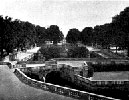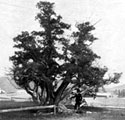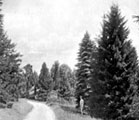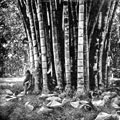Historical Essays on Garden and Forest
"Master of a Felicitous English Style":
William Augustus Stiles, Editor of Garden and Forest
by Phyllis Andersen
When we think of it, we cannot but recognize that few people have written about parks as Stiles wrote. Olmsted and Vaux, yes, and Whately. It was literature they wrote . . . in addition to facts, Stiles had that literary touch, the penetrative, imaginative quality that no horticulturist had whom I have ever known. He claimed nothing original, the writings and sayings of Olmsted and Vaux being his authority, but he illuminated all they had given him with the lambent flame of his literary genius. -Samuel Parsons Jr., 1926
Stiles' Important Role
|
|
Charles Sprague Sargent was the self-appointed "conductor" of the nineteenth-century journal Garden and Forest.1 Like all maestros he has been given almost sole credit for the journal's achievements: its timely reports of horticultural advances, its prescient warnings of threats to forests and scenery, and its unique linking of disciplines. Sargent did have significant expertise in the many fields covered in Garden and Forest, but he was less a savant than a manager who knew how to pick a good team. Credit for the graceful prose and for the eloquent advocacy for public parks should go not to Sargent, but to Garden and Forest's editor William Stiles. Stiles, an experienced New York journalist who also enjoyed a distinguished career in public service, was appointed "managing editor" by the founders of the journal in 1888. The editorial office of Garden and Forest was located in the Tribune Building in New York, and Stiles continued in his long-established role of editorial writer for the New York Tribune during his tenure as editor of Garden and Forest. Sargent "conducted" from his base at the Arnold Arboretum in Boston, where he was director.
|
|
Stiles' role in Garden and Forest has not been widely recognized, not because it was intentionally obscured by Sargent, who fully appreciated both his editorial skills and his character, but rather by routine library practice. The full masthead of Garden and Forest listing staff names and positions, editorial mission, and contributors was positioned in the front of the publication in an advertising section. When the issues were subsequently bound by libraries, the advertising sections were commonly removed as having no future value. Hence the information about Stiles' role was lost, as well as the advertisements, now recognized as historically significant in their own right. What remained was an abbreviated masthead on the first editorial page listing Charles Sprague Sargent as Conductor. Stiles' role was further obscured by the fact that most of the lead editorials of the journal, many of them authored by Stiles, were unsigned.
Advocate for Public Parks
|
|
William Augustus Stiles was born in Deckertown (now Sussex), New Jersey, on March 9, 1837. His father, Edward Augustus Stiles, was a mathematician and educator who founded Mount Retirement Seminary, a successful preparatory school in northern New Jersey. His mother was the former Eveline Belmont Howell. William was educated at his father's school and at Yale, graduating from Yale in 1859. He returned briefly to the Mount Retirement Seminary to teach, but in 1864, hoping that a sea voyage would improve his health, particularly the weak eyesight that was to plague him all of his life, he traveled to California by way of the Isthmus of Panama. He briefly held a teaching post in Oakland, but soon left to join the corps of engineers laying out the new Union Pacific Railroad line across the Sierra Nevadas. However, his weak eyesight, further strained by detailed mapmaking, forced him to return to his father's farm in New Jersey for a period of recuperation. Having formed an interest in plants during his time in California, Stiles now began a systematic study of plants, collecting in the wild and cultivating nursery stock. Later, his interests expanded to include forestry, agricultural technology, and landscape gardening. He also became interested in local politics during this period and later ran for New Jersey state offices several times. After a brief stint as a gauger (or tax collector) in New York City he began his career in journalism.
|
|
Samuel Parsons Jr., landscape architect for the New York City Department of Parks in the 1890s, tells the story of an after-dinner speech Stiles made to a group of Yale alumni in New York in the late 1870s. According to Parsons, Stiles' wit and intelligence so captivated Whitelaw Reid, publisher of the New York Tribune, that he engaged Stiles on the spot as an editorial writer for the Tribune, a position he was to hold until the end of his life.2 In 1883 Stiles also became the agricultural correspondent for the Philadelphia Weekly Press, reporting on current research in agricultural methods.
Stiles' early writings for the Tribune established him as a thoughtful and knowledgeable spokesman for local issues. ("There was nothing of the superficial smartness of the ordinary newspaper man, but his articles were written in a grave and judicious style, with a fine literary quality." )3 He quickly focussed on public parks, advocating additions to New York City's parklands and objecting to what he saw as misguided efforts to improve those already established-particularly Central Park
Stiles and Olmsted
|
|
The early 1880s were a period of significant controversy for Central Park. Like all large public works projects the park had become a rallying point for those seeking quick recognition in local politics. The pent-up frustrations of those not in sympathy with the Olmsted and Vaux design resulted in a questioning of priorities. They questioned the park's dedication to the passive enjoyment of scenery, asking what classes of society were best served by this type of park. Inappropriate intrusions in the form of active recreation facilities and popular amusements were proposed. In his editorials Stiles positioned himself as a staunch defender of the Olmsted-Vaux vision. Frederick Law Olmsted Jr. and Theodora Kimball, in the introduction to their bibliography of works on Central Park in Forty Years of Landscape Architecture: Central Park, note the significance of Garden and Forest's coverage of park issues: "The history of Central Park during the critical ten-year period covered by Garden and Forest (begun in 1888 and edited by friends and warm defenders of the Park) is so well reflected in its pages that perhaps a disproportionate number of references-all to editorials-in this periodical have been here included."4
|
|
Stiles and Olmsted had a long-standing professional friendship. When Charles Sargent became ill in early 1888, just before the launch of Garden and Forest, Olmsted, who had contributed $500 to the initial financing of the journal, stepped in to offer advice and support to the new editor. The correspondence between Stiles and Olmsted, who had by then relocated to Brookline, Massachusetts, reveals Stiles' gratitude to Olmsted for his suggestions of topics and authors for the journal. Olmsted, like many others, valued Stiles' views on the transformation of the field of landscape gardening into the profession of landscape architecture. In a letter of advice to his son Fred Jr., Olmsted reflected on his own role and that of others in the emerging profession: "It is as if the war had just begun and my part had been to keep the enemy in check until reinforcements could arrive. These young men, John [Olmsted], Harry [Codman], [Charles] Eliot and [Charles] Coolidge, with Sargent and Stiles and Mrs. Van Rensselaer, are the advance of the reinforcements."5
In 1892 Stiles began to use the editorial columns of Garden and Forest and the New York Tribune to call attention to a proposed speedway through Central Park along its western boundary, a project he felt was totally contrary to Olmsted and Vaux's vision: "[This project] would make an offensive exhibition of the power of money to confiscate for the pleasure of a few rich men the ground which offers to the poor of the city their only opportunity to enjoy the sight of verdant fields."6
|
|
In 1895 the newly elected mayor of New York, William L. Strong, appointed William Stiles to the Board of Park Commissioners, a politically powerful body with substantial influence over capital expenditures. Shortly after Stiles' appointment, the speedway proposal was resurrected, this time not in Central Park but along the west bank of the Harlem River. An engineering firm was to design it rather than Calvert Vaux, who was then landscape architect for the New York City Parks Department. This was only one of a series of humiliating attacks on Vaux from members of the Park Board who continued to try to discredit him for his participation in stopping the Central Park speedway proposal. Lacking the thick skin so useful to those in public service, Vaux suffered under these attacks. He needed a protector, and William Stiles gladly accepted the role, rallying support for Vaux from a significant number of prominent New Yorkers. Vaux's son Bowyer said that Stiles had "perhaps a keener appreciation" of his father's genius than any other citizen.7
William Stiles died on October 6, 1897, at the home of his sister Mrs. E. H. Davey. Never married, he had remained close to his two sisters and to the family property in northern New Jersey. In the fulsome style of the period, the obituary notices praised his contributions to the protection of the parks of New York and to the responsibility of government and civic leaders to serve the needs of the disadvantaged. The memorial notice published in the October 13, 1897, issue of Garden and Forest, unsigned but undoubtedly written by Charles Sargent, underscored Stiles' "inflexible purpose":
He has been more, however, than a brilliant and successful editor of a technical journal; keen love of nature and sympathy with the cravings of the poor shut within city walls from the sight and enjoyment of the country made him fully understand the value and true meaning of urban parks, and for twenty years, always with that modesty which was one of his strongest characteristics, but with inflexible purpose, he has stood between the parks of this city and men who at different times and under different pretenses have tried to deface them. . . . His death is a serious loss to the readers of Garden and Forest and to every one in the United States interested in landscape-gardening, horticulture and the care and protection of our national and state forests.
|
|
Garden and Forest ceased publication in 1898. Despite the high quality of its writing, its appeal to practitioners in many fields, its international interests and noted contributors, the magazine had always run at a loss; Sargent had been covering its deficit for years. But it may have been the loss of Stiles that decided the issue, for Sargent's major responsibility at that time was building the scientific credibility of the Arnold Arboretum. The magazine had been in many ways Sargent's experiment. In addition to reporting on "all progress in science and practice "-horticulture, "garden botany," dendrology, scientific and practical forestry-it deliberately linked these fields with landscape gardening. It even stretched its mission to link landscape gardening with architecture. Stiles' appointment as editor of Garden and Forest gave it a lively, stylish prose comparable to that of journals of a more general nature: Century Magazine, Putnam's Magazine, North American Review. While there were other magazines devoted to horticulture and garden-making, they were written and edited by horticulturists and nurserymen and lacked the international scope and literary style of Garden and Forest. "His mastery of a felicitous English style and his profound and sympathetic knowledge of floral and arboreal life made him one of the most instructive and charming of contemporary writers; with refined taste and sturdy integrity . . ."8
AUTHOR: Phyllis Andersen is director of the Institute for Cultural Landscape Studies of the Arnold Arboretum.
NOTES
1. Note on sources: The basic facts of Stiles' life were constructed from the extensive obituary notices published at his death: New York Tribune, 7 October 1897; New York Times, 7 October 1897; Garden and Forest, 13 October 1897. M. S. Coulston's biographical entry on William Stiles in Liberty Hyde Bailey's Cyclopedia of American Horticulture, 1902, was also consulted, as well as correspondence between Stiles and Frederick Law Olmsted from early 1888 (Frederick Law Olmsted Papers, Library of Congress).
2. Mabel Parsons, ed., Memories of Samuel Parsons (New York: Putnam's, 1926), 127.
3. Parsons, 128.
4. Forty Years of Landscape Architecture: Central Park, 563.
5. Frederick Law Olmsted, Sr. to Frederick Law Olmsted, Jr., 5 September 1890.
6. Frederick Law Olmsted, Sr. to Frederick Law Olmsted, Jr., 5 September 1890.
7. C. Bowyer Vaux to John C. Olmsted, 8 December 1895, quoted in Francis R. Kowsky, Country, Park, and City: The Architecture of Calvert Vaux (New York: Oxford University Press, 1998), 319.
8. New York Tribune, 7 October 1897.









